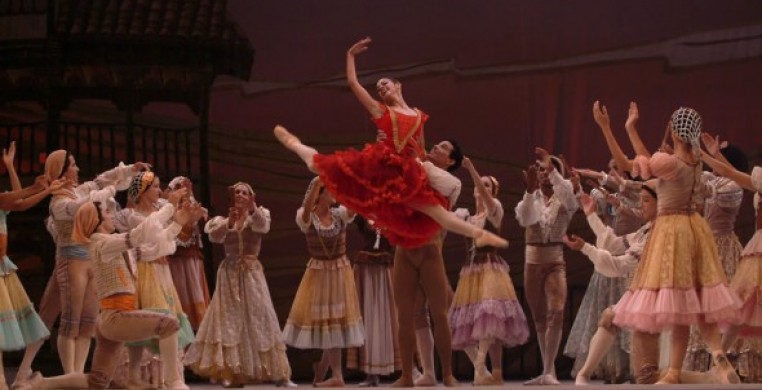I came to Ballet Nacional de Cuba’s performance of Don Quixote at the Auditorium Theatre last Saturday night with high expectations. Alicia Alonso, the company’s 97-year-old founder and director, is legendary as one of the great ballerinas of the 20th century, her performing career bridging into her seventies. The school and company she established in Havana is legendary for turning out superbly trained technicians, and the company’s prima ballerina, Viengsay Valdes, a legendary artist in her own right, was returning to Chicago with the company for the first time in fifteen years to reprise her critically-acclaimed role as Kitri. Alicia Alonso
Alicia Alonso
I have to confess that while I have seen the Act Three grand pas de deux performed countless times, I hadn’t witnessed the full-length production since the Bolshoi Ballet’s performance at McCormick Place when I was a mere teen. Ekatrina Maximova’s Kitri was so electrifying that to this day, I can still envision her fiery personality and matching tu-tu igniting the stage with thirty-two incendiary fouetté turns. “That’s how I want to dance!” I said to myself at the time, and that was what I expected to see this time.
Alas, Saturday’s cast, with Sadaise Arencibia in the role of Kitri, delivered a workmanly rendition of an overworked 19th-century warhorse, with a few stand-out moments of technical brilliance. Alonso’s uninspiring extrapolation of the 1869 Petipa/Gorsky choreography used the threads of a thread-bare story to provide lead dancers a chance to show off their technical prowess, sprinkling a dreamy Don Quixote (Yansiel Pujada) and his comic relief man, Sancho Panza (Brian Gonzales) into the mix as contextual commentary to a side-story from the Cervantes novel.
The production was blessed by the always excellent Chicago Philharmonic under the direction of BNDC conductor, Giovanini Duarte, performing the original ballet score by Ludvig Minkus. Many of the music’s lush passages were lost on the largely mechanical execution of the corps, however, and liberties with timing distorted musicality in favor of technical show. Maureen Gil as the the Dryad, Love, in the Act Two dream ballet found lyricism and performed with notable musicality, as did Bárbara Fabelo as Queen the Dryads.
Corps de ballet variations were repetitive throughout the three-act evening, with little differentiation other than costumes between the Act One villagers, the Act Two Gypsies and Dryads, and the Act Three wedding guests. Flashy performances by the the Act One Bullfighters, led by a charismatic Rafael Quenedit, brought welcome excitement. His two duets with partner Ely Regina enlivened the village square with crisply executed variations and plenty of Latin sizzle.
Not so Arencibia’s Kitri and Raul Abreu’s Basilio, the central protagonists of the story, who each demonstrated impressive technical mastery of devilishly tricky material, but lacked chemistry as a couple, to the detriment of any real sense of suspense or dramatic arc. Arencibia’s Kitri hit all her marks, and held some unsupported poses en pointe for oh-so-long, but her acting fell short of genuine character portrayal, sinking rather to pasted-on facial expressions and a lack of spontaneity in response to her scene partners. A charming Abreu brought both stunning technical fireworks and warmth to his portrayal of Basilio, and the two carried off an Act Three coda that redeemed the evening with plenty of the virtuosic dancing ballet lovers go to see.

